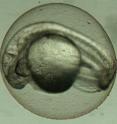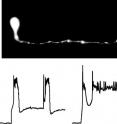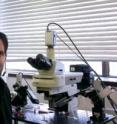Unique spinal nerve cell activity discovery announced by University of Leicester biologists
Related images
(click to enlarge)
Scientists from the University of Leicester have hit upon unique forms of spinal nerve activity that shape output of nerve cell networks controlling motor behaviours. The breakthrough in the Department of Biology at the University of Leicester was announced Nov 8 in the journal Current Biology.
Although the neural basis of motor control has been studied for over a century, the processes controlling maturation of locomotor behaviours -- like walking and swimming -- are not fully understood.
The University of Leicester research into nerve cells responsible for motor behaviours was carried out on fish. The team aimed to understand how spinal networks produce rhythmic activity from a very immature stage -- and how such activity changes during maturation.
The team used zebrafish, a freshwater fish native to northern India and Bangladesh, because their motor networks are similar to humans. However, as they are fertilized outside the mother and their embryos are transparent, scientists can readily monitor motor network development from its onset -- something that is very difficult to do in mammals.
Lecturer in Neurobiology, Dr Jonathan McDearmid, who led the research, said: "What's unique about our work is the observation that a group of spinal nerve cells generate unusual forms of electrical activity that adapt to meet the changing requirements of the developing motor network. Whilst these cells had been previously identified, their excitable properties had not been studied in detail. We found that these cells produce age-specific activity patterns: in early life they have "autorhythmic" properties that are likely to drive embryonic movements. However, as fish develop towards more mature swimming stages, they switch firing activity to generate sustained impulses that appear to be necessary for maintenance of swimming.
"Our work is important because it sheds light on the mechanisms by which spinal nerve cells shape activity in the maturing of motor network. This is basic research that allows us to better understand how vertebrate motor activity emerges. However, in the long term, understanding of this process might help determine what goes wrong in diseases that affect spinal cord function."
Dr McDearmid said the identification of the activity generated by this group of cells -termed IC cells- happened as quite a surprise: "It was two days after Christmas when we first observed IC cells generating these unusual patterns of activity. I was conducting a few routine experiments for a related study we were running in parallel. Whilst monitoring electrical responses in different nerve cells I hit on a cell that did some very unusual things. It was a very exciting finding indeed. The only problem was that subsequent attempts to find this "magic cell" didn't prove straightforward. Because these cells change location as the fish develops, it initially proved challenging to track them down for further study. Still, in time we figured out where these cells were and that very first recording turned out to be one of the best Christmas presents we've ever had."
Researchers say they have a long way yet to go in the study -- and many questions remain unanswered. Dr McDearmid said: "We have many questions that we want to ask next. Are there other cells in the developing spine that display similar types of activity? Also, we currently have no idea how IC cells function at more mature stages, such as in adult fish. Our next aim is to determine whether IC cells retain their unusual firing characteristics at older stages."
Dr McDearmid worked with Dr Huaxia Tong, a postdoc who co-authored the study. The three- year study was funded by the Biotechnology and Biological Sciences Research Council (BBSRC).
Source: University of Leicester
Other sources
- Unique spinal nerve cell activity: Novel forms of activity linked to development of motor behaviors such as swimmingfrom Science DailyThu, 8 Nov 2012, 19:30:56 UTC
- Discovery may help nerve regeneration in spinal injuryfrom Science DailyWed, 7 Nov 2012, 1:20:14 UTC


